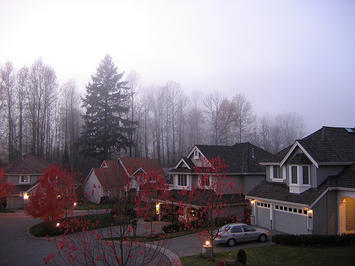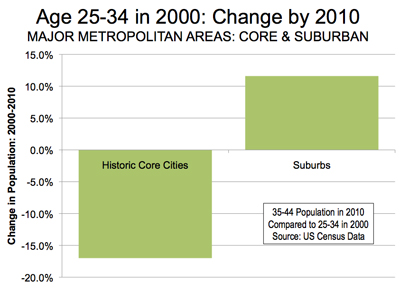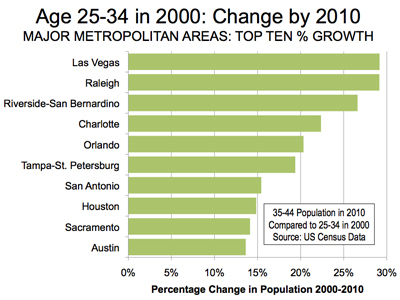
For well over a decade urban boosters have heralded the shift among young Americans from suburban living and toward dense cities. As one Wall Street Journal report suggests, young people will abandon their parents’ McMansions for urban settings, bringing about the high-density city revival so fervently prayed for by urban developers, architects and planners.
Some demographers claim that “white flight” from the city is declining, replaced by a “bright flight” to the urban core from the suburbs. “Suburbs lose young whites to cities,” crowed one Associated Press headline last year.
Yet evidence from the last Census show the opposite: a marked acceleration of movement not into cities but toward suburban and exurban locations. The simple, usually inexorable effects of maturation may be one reason for this surprising result. Simply put, when 20-somethings get older, they do things like marry, start businesses, settle down and maybe start having kids.
An analysis of the past decade’s Census data by demographer Wendell Cox shows this. Cox looked at where 25- to 34-year-olds were living in 2000 and compared this to where they were living by 2010, now aged 35 to 44. The results were surprising: In the past 10 years, this cohort’s presence grew 12% in suburban areas while dropping 22.7% in the core cities. Overall, this demographic expanded by roughly 1.8 million in the suburbs while losing 1.3 million in the core cities.
In many ways this group may be more influential than the much ballyhooed 20-something. Unlike younger adults, who are often footloose and unattached, people between the ages of 35 and 44 tend to be putting down roots. As a result, they constitute the essential social ballast for any community, city or suburb.
Losing this population represents a great, if rarely perceived, threat to many regions, particular older core cities. Rust Belt centers such as Cleveland and Detroit have lost over 30% of this age group over the decade.
More intriguing, and perhaps counter-intuitive, “hip and cool” core cities like San Francisco, New York and Boston have also suffered double-digit percent losses among this generation. New York City, for example, saw its 25 to 34 population of 2000 drop by over 15% — a net loss of over 200,000 people — a decade later. San Francisco and Oakland, the core cities of the Bay Area, lost more than 20% of this cohort over the decade, and the city of Boston lost nearly 40%.
In contrast, the largest growth among this peer group took place in metropolitan areas largely suburban in form, with a strong domination by automobiles and single-family houses. The most popular cities among this group — with increases of over 10% — were Las Vegas; Raleigh, N.C.; Riverside-San Bernardino, Calif.; Charlotte, N.C.; Orlando, Fla.; San Antonio, Houston and Dallas-Fort Worth, in Texas; and Sacramento, Calif..
Furthermore, most of the growth took place not in the urban centers of these regions but in the outlying suburbs. This cohort expanded by more than 40% Raleigh’s suburbs — 37,000 people — over the decade. Houston’s suburbs gained the most of any region of the country, adding 174,000 members of this particular generation.
These findings should inform the actions of those who run cities. Cities may still appeal to the “young and restless,” but they can’t hold millennials captive forever. Even relatively successful cities have turned into giant college towns and “post-graduate” havens — temporary way stations before people migrate somewhere else. This process redefines cities from enduring places to temporary resorts.
Rather than place all their bets on attracting 20-somethings cities must focus on why early middle-age couples are leaving. Some good candidates include weak job creation, poor schools, high taxes and suffocating regulatory environments. Addressing these issues won’t keep all young adults in urban settings, but it might improve the chances of keeping a larger number.
Our findings may also give pause to those developers who often buy at face value the urbanist narrative about an city-centric real estate future. In the last decade, many developers have anticipated a continuing tsunami of wealthy young professionals, as well as legions of “empty-nesters,” flowing into the urban cores. This led to a rash of high-end condominium developments. Yet in the end, the condo market turned out far less appealing than advertised, crashing virtually everywhere from Chicago and Las Vegas to Atlanta, Portland and Kansas City. This has left many investors with empty units, distress auctions or far less profitable rentals.
One hopes the development community might still learn something from that failure. But the Urban Land Institute among others increasingly maintain that vast new frontiers for new high-density growth will develop in the inner-ring suburbs. Yet in many areas with strong central cores, such as New York, Seattle and Chicago, inner suburbs usually grew slowly, particularly in comparison with the further out peripheral expanses.
Critically, the notion of mass suburban densification is likely to meet strong resistance from local residents. This will be particularly marked in attractive, affluent “progressive” areas like the Bay Area’s Marin County, Chicago’s North Shore suburbs and New York’s Hudson Valley. People who move to these places are attracted by their leafy, single-family-home-dominated neighborhoods and village-like shopping streets. Nothing short of economic catastrophe or government diktat would make them accept any intense program of densification.
Of course, some urbanists claim that the new millennial generation, born after 1983, will prove “different” from all their predecessors. Yet research to date finds older millennials may prove more attracted to suburban living than many density advocates suggest. According to a survey by Frank Magid and Associates, more millennials consider suburbs as their “ideal place” to settle than do older groups.
As generational chroniclers Morley Winograd and Mike Hais have noted, the fact that most millennials plan to get married and have children only reinforces this trend over time. Another problem may prove that millennials may be running out of ideal urban options. Back in the 1990s it was far easier to buy a home in one of the nation’s handful of really attractive cosmopolitan urban settings — for example, brownstone Brooklyn, Northside Chicago, LA’s beach communities or San Francisco. Today these areas suffer some of the highest housing prices relative to incomes of any places in the country.
Rather than blindly accept the vision of a mass movement back to the urban centers, developers might focus instead on what kind of housing, and community, addresses the needs and affordability concerns of millennials as they move into full adulthood. Over the next ten years, the number of millennials entering their mid-30s will expand by over 40 million – a population larger than those of elderly residents who will be old enough to give up their homes.
This large group is also most likely to continue moving to the lower-density, more affordable South and West. These areas already boast disproportionate percentages of millennials, Hais and Winograd report.
It’s time for developers and planners to look more closely at how young adults as they enter their 30s vote with their feet. Unless there has been a mind-numbing change in attitude or an unexpected return to good governance in cities, young adults entering middle age will continue their shift toward suburban and lower-density areas in the decade ahead, upending the predictions of most pundits, planners and development experts.
This piece originally appeared at Forbes.com.
Joel Kotkin is executive editor of NewGeography.com and is a distinguished presidential fellow in urban futures at Chapman University, and an adjunct fellow of the Legatum Institute in London. He is author of The City: A Global History. His newest book is The Next Hundred Million: America in 2050
, released in February, 2010.
Photo by mamamusings, Liz Lawley, Upstairs Window - Encroaching fog















Smaller Cities?
Has the author considered the growth of the smaller cities. Typically, they feature urban landscapes, mixed-uses, and civic amenities; in other words, they are decidedly urban. However, they don't suffer from the same maladies of the large metropolitan cities, at least not in extent and intractability and their revenues can be more stable. It is a false dichotomy between major cities and single-family suburbs. On another note, to cite Cleveland and Detroit as losers of a certain cohort is to ignore the enormous loss among all cohorts!
Kotkin is an idiot
Joel,
The reason you are such an insufferable idiot, fool, fear-monger, and, all-around schmuck is that you ALWAYS confuse data for preference. If central cities had great schools, all these Millenials you have fleeing to suburbia would stay in the city. But you never, ever, ever talk about suburban migration as a question of need, not choice. Certainly not 100% of the "young and restless" would stay in the city, but I'd venture to say a majority would.
Have you ever thought of actually ASKING some of the young families who left the city whether they did so by choice or necessity? What a novel concept that would be!!
I hope you take a long suburban walk off a short urban pier and stop compelling people to fulfill your twisted prophesy of urban decline by implying that anyone who celebrates cities is a misinformed fool.
I hate you so much it makes my stomach churn. Please, for the sake of all humanity, disappear into the ether and never emerge again.
Cohorts
Mr. Kotkin,
Mr. Cox follows the 25-34 (in 2000) age cohort from 2000 and 2010, and concludes that there has been no "shift among americans to dense urban living", or reversal of white flight.
Mr. Cox's evidence doesn't support his (or your) conclusions. He's confounding the changes associated with the aging of a cohort with a national trend. We already knew that people tend to move to the suburbs as they age and have children. The relevant measure is the proportion of each generation living in the city, not what a particular cohort does over time.
It’s quite possible that the same cohort Wendell Cox is looking at is more likely to live in the city than their parents were at that age.
Michael Farrell
Wendell Cox is rarely a solid reference
Any time this man is quoted or used to underpin a thesis, I immediately start to doubt its veracity. Wendell Cox practices highly selective analysis to produce questionable findings in support of the status quo: suburbia is what people want, so we'd better keep providing it. He has also been known to produce findings suggesting that suburbia is the most sustainable form of development.
Selecting your ideology and then seeking out evidence to support it is not the most objective approach to research.
I have not taken the time to investigate whether Wendell Cox's conclusions referenced here seem plausible or not, but I would recommend anyone who finds this article persuasive to investigate his claims carefully.
Not Surprising
The whole economics of this country reinforce suburban lifestyles. Subsidized mortgages, highway subsidies, low gas taxes, low density enforcing zoning laws, etc all reinforce new greenfield suburban development. That young families move to the suburbs is not necessarily a question of taste, it's mostly a financial equation that all levels of government enforce. If Fannie and Freddie starting subsidizing renovations for existing homes the way they do for new construction, if we raised the gas tax to be even half of what it is in Europe, if we reduced minimum parking requirements, if we stopping investing billions in new roads, these trends would likely slow or reverse. The inherent cost benefits of building or rebuilding in existing areas would become more apparent and young families would be seen in many more types of places within cities - inner city, inner suburb, suburb and exurb. Why should we be picking and choosing different development patterns?
Roadsider's Comment Is Right On Point
I agree with Roadsider. The schools in most urban districts are failing miserably. And besides that, who wants a family life in the middle of an urban center. Sure, maybe we can walk to ballgames and to shopping areas....if we don't get robbed, shot, or both on the way there.
young people move to the city? really?
Thank you Mr. Kotkin for digging into this and writing about it. It makes me want to hunt down some census figures that enough young people move into the city for it to be worth talking about.
I've always lived in the city. But when I was young I knew just as many people my age that lived in the suburbs. My dating activities far too often involved me biting my tongue and driving out to a TGIF for a meal with a nice woman.
So while I knew lots of people living in the city, I wonder if enough of them migrate from a city to a suburb to even be worth talking about.
Maybe the census numbers aren't detailed enough to help us see all of the 20 year olds that live in the city on campus and then when they graduate take a job in a suburb and move out that way too?
It's the schools, stupid.
Young people move out of the cities because they get married and have kids, and unless they're exceeding wealthy and can afford private education, they move to the suburbs where they don't buy a house, they buy access to better schools. That's it in a nutshell.
To a person, every young couple I've ever met who established themselves in the city moved out of the city after they had kids for one simple reason: Schools.
You can do all the research and demographic studies you want, but families gravitate towards the places with the best schools they can afford. In the suburbs, the cost of the education includes a house and a piece of land. Not a bad deal, even when the house is built like crap.
This trend will reverse if and when we realign our priorities about what makes a great city; that it's not convention centers, football stadiums, aquariums, or other big ticket, feather-in-a-cap items. It's all about fixing the schools, cleaning the parks, and securing the streets. Do that, and watch the suburbs turn into ghost towns and havens for meth labs.
Right On
Well said, Roadsider.
There needs to be a revolution in the terms of what makes a city attractive. It's not tall skyscrapers, stadiums or cutesy shops or museums. Add streetcars to that mix as well.
It's schools and quality of life. It's about the feeling of being safe, clean, and inside a comfortable environment. Cities will need to start enforcing quality of life crimes much more than they do right now. Think more along the lines of Singapore than New York City.
I'd say inserting the values of the suburbs with that of the built form of the cities will create a very pleasant environment.
Urbanism will not work if it does not address quality of life issues first. They need more human infrastructure, less built infrastructure...
Schools & Housing
I agree with Roadsider on this issue. Schools are the #1 most important reason families move to the suburbs. I know plenty of young couples who would kill to continue living downtown where their commute is more reasonable, ammenities and services are close at hand, and there is more culture, but the quality of school systems and the cost of housing are the two deterrents. By moving the suburbs, you potentially sacrifice actually spending time with your children because you are stuck in a longer commute. A typical family's most important and significant investment - a home - is based on schools, and yet developers and planners don't engage the school systems. It could be said that the school systems are the #1 force generating the stream of people to suburbs, and yet most planners and urbanists can't fathom tackling the education system.
European and Canadian cities such as Vancouver have done a good job in keeping children in cities. The school systems are a high quality and housing developments cater to families as well as singles, empty nesters, etc. There are day-care centers right in the heart of downtown. They recently built an elementary school downtown Vancouver that has so much demand for new students, parents have been known to camp out to get their child's name on the list. (Clearly, demand is greater than the supply of schools - build another school!) There are family-sized units (3, 4 bedroom condos). Granted, housing is expensive downtown, and as a family grows, they require more space, which is increasingly costly. However, if the school systems were good downtown, I would gladly pay more for housing to spend more time with my family. Chances are I would be spending less on transportation and I wouldn't be punishing myself and my family to countless hours lost sitting in the car.
And to the comment about raising a child downtown being dangerous, I disagree as well. Safe cities are cities with people. Dangerous cities are cities that shut down at 5:00. Cities with residential land uses don't shut down at 5:00 - there are people around to make it a safe place to be. Furthermore, the suburbs were built for the car, and auto-related deaths are the leading cause of unintentional deaths among children. In the city, traffic speeds are often slower, and thus less likely to kill people. In the suburbs, speeds above 25 miles per hour are more likely to kill someone than simply injure them.
I agree that developers need to supply the correct products if we are to develop dense, livable areas for people of all ages and families in all stages. This includes getting developers involed in the education game if cities and school systems will not.